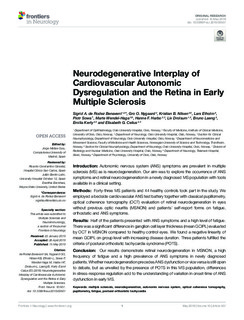| dc.contributor.author | Benavent, Sigrid Aune de Rodez | |
| dc.contributor.author | Nygaard, Gro Owren | |
| dc.contributor.author | Nilsen, Kristian Bernhard | |
| dc.contributor.author | Etholm, Lars | |
| dc.contributor.author | Sowa, Piotr | |
| dc.contributor.author | Gustavsen, Marte Wendel | |
| dc.contributor.author | Harbo, Hanne Flinstad | |
| dc.contributor.author | Drolsum, Liv | |
| dc.contributor.author | Laeng, Bruno | |
| dc.contributor.author | Kerty, Emilia | |
| dc.contributor.author | Celius, Elisabeth Gulowsen | |
| dc.date.accessioned | 2019-10-02T07:03:20Z | |
| dc.date.available | 2019-10-02T07:03:20Z | |
| dc.date.created | 2019-06-17T10:17:36Z | |
| dc.date.issued | 2019 | |
| dc.identifier.citation | Frontiers in Neurology. 2019, 10:507 1-9. | nb_NO |
| dc.identifier.issn | 1664-2295 | |
| dc.identifier.uri | http://hdl.handle.net/11250/2619699 | |
| dc.description.abstract | Introduction: Autonomic nervous system (ANS) symptoms are prevalent in multiple sclerosis (MS) as is neurodegeneration. Our aim was to explore the occurrence of ANS symptoms and retinal neurodegeneration in a newly diagnosed MS population with tools available in a clinical setting.
Methods: Forty-three MS patients and 44 healthy controls took part in the study. We employed a bedside cardiovascular ANS test battery together with classical pupillometry, optical coherence tomography (OCT) evaluation of retinal neurodegeneration in eyes without previous optic neuritis (MSNON) and patients' self-report forms on fatigue, orthostatic and ANS symptoms.
Results: Half of the patients presented with ANS symptoms and a high level of fatigue. There was a significant difference in ganglion cell layer thickness (mean GCIPL) evaluated by OCT in MSNON compared to healthy control eyes. We found a negative linearity of mean GCIPL on group level with increasing disease duration. Three patients fulfilled the criteria of postural orthostatic tachycardia syndrome (POTS).
Conclusion: Our results demonstrate retinal neurodegeneration in MSNON, a high frequency of fatigue and a high prevalence of ANS symptoms in newly diagnosed patients. Whether neurodegeneration precedes ANS dysfunction or vice versa is still open to debate, but as unveiled by the presence of POTS in this MS population, differences in stress-response regulation add to the understanding of variation in onset-time of ANS dysfunction in early MS. | nb_NO |
| dc.language.iso | eng | nb_NO |
| dc.publisher | Frontiers Media | nb_NO |
| dc.rights | Navngivelse 4.0 Internasjonal | * |
| dc.rights.uri | http://creativecommons.org/licenses/by/4.0/deed.no | * |
| dc.title | Neurodegenerative interplay of cardiovascular autonomic dysregulation and the retina in early multiple sclerosis | nb_NO |
| dc.type | Journal article | nb_NO |
| dc.type | Peer reviewed | nb_NO |
| dc.description.version | publishedVersion | nb_NO |
| dc.source.pagenumber | 1-9 | nb_NO |
| dc.source.volume | 10:507 | nb_NO |
| dc.source.journal | Frontiers in Neurology | nb_NO |
| dc.identifier.doi | 10.3389/fneur.2019.00507 | |
| dc.identifier.cristin | 1705303 | |
| dc.description.localcode | Copyright © 2019 de Rodez Benavent, Nygaard, Nilsen, Etholm, Sowa, Wendel-Haga, Harbo, Drolsum, Laeng, Kerty and Celius. This is an open-access article distributed under the terms of the Creative Commons Attribution License (CC BY). The use, distribution or reproduction in other forums is permitted, provided the original author(s) and the copyright owner(s) are credited and that the original publication in this journal is cited, in accordance with accepted academic practice. No use, distribution or reproduction is permitted which does not comply with these terms. | nb_NO |
| cristin.unitcode | 194,65,30,0 | |
| cristin.unitname | Institutt for nevromedisin og bevegelsesvitenskap | |
| cristin.ispublished | true | |
| cristin.fulltext | original | |
| cristin.qualitycode | 1 | |

